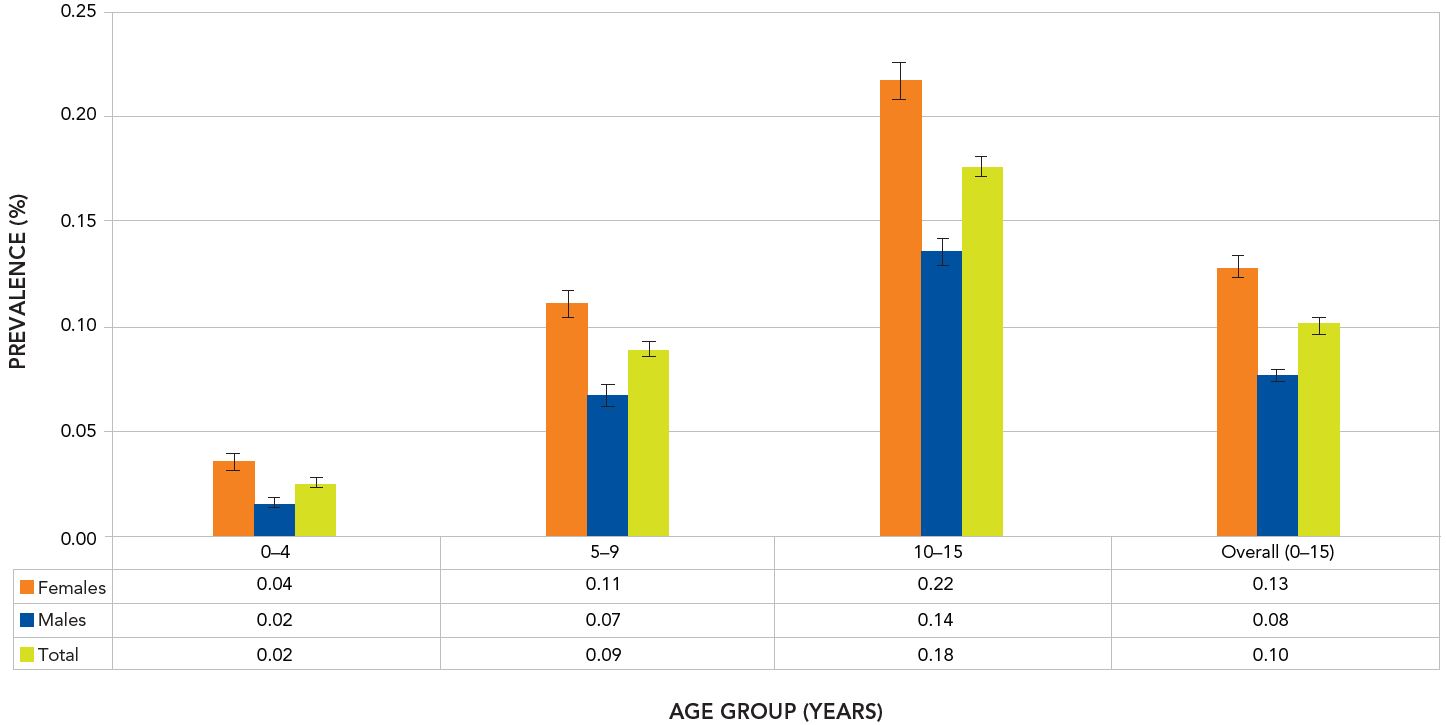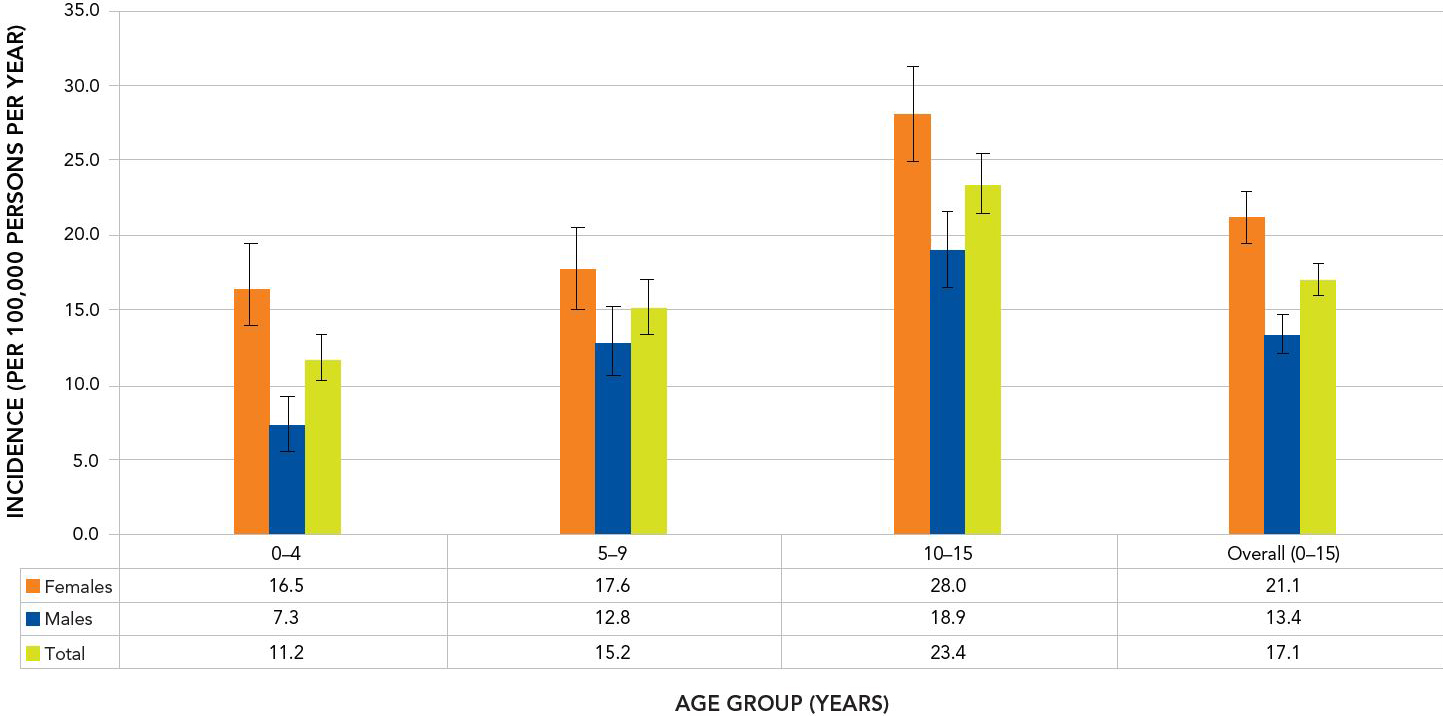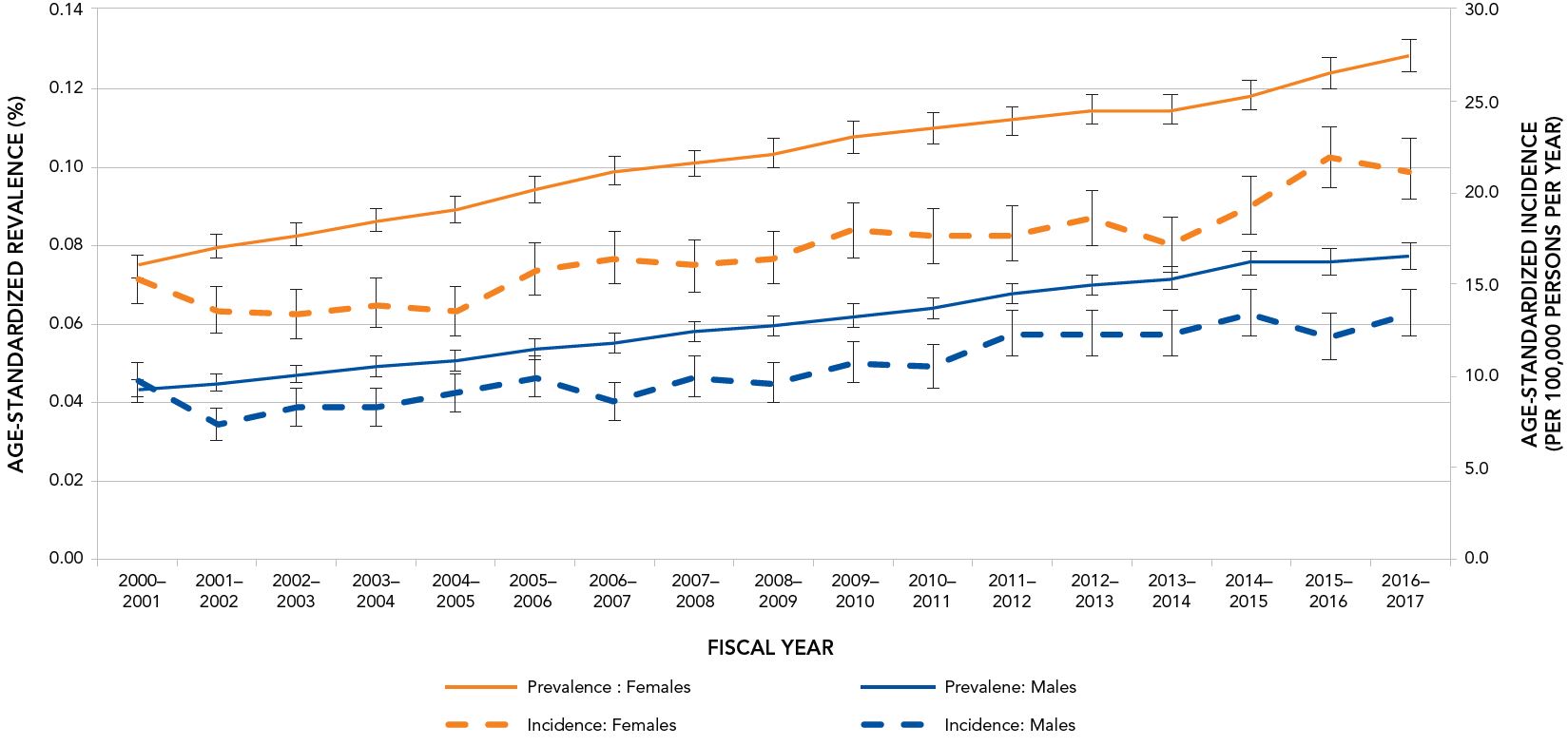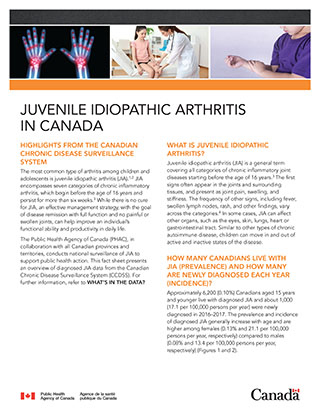Juvenile idiopathic arthritis in Canada
Download in PDF format
(1.9 MB, 6 pages)
Organization: Public Health Agency of Canada
Published: September 2020
Highlights from the Canadian Chronic Disease Surveillance System
The most common type of arthritis among children and adolescents is juvenile idiopathic arthritis (JIA).Footnote 1Footnote 2 JIA encompasses seven categories of chronic inflammatory arthritis, which begin before the age of 16 years and persist for more than six weeks.Footnote 3 While there is no cure for JIA, an effective management strategy, with the goal of disease remission with full function and no painful or swollen joints, can help improve an individual's functional ability and productivity in daily life.
The Public Health Agency of Canada (PHAC), in collaboration with all Canadian provinces and territories, conducts national surveillance of JIA to support public health action. This fact sheet presents an overview of diagnosed JIA data from the Canadian Chronic Disease Surveillance System (CCDSS). For further information, refer to What's in the data?
What is juvenile idiopathic arthritis?
Juvenile idiopathic arthritis (JIA) is a general term covering all categories of chronic inflammatory joint diseases starting before the age of 16 years.Footnote 3 The first signs often appear in the joints and surrounding tissues, and present as joint pain, swelling, and stiffness. The frequency of other signs, including fever, swollen lymph nodes, rash, and other findings, vary across the categories.Footnote 4 In some cases, JIA can affect other organs, such as the eyes, skin, lungs, heart or gastrointestinal tract. Similar to other types of chronic autoimmune disease, children can move in and out of active and inactive states of the disease.
How many Canadians live with JIA (prevalence) and how many are newly diagnosed each year (incidence)?
Approximately 6,200 (0.10%) Canadians aged 15 years and younger live with diagnosed JIA and about 1,000 (17.1 per 100,000 persons per year) were newly diagnosed in 2016–2017. The prevalence and incidence of diagnosed JIA generally increase with age and are higher among females (0.13% and 21.1 per 100,000 persons per year, respectively) compared to males (0.08% and 13.4 per 100,000 persons per year, respectively) (Figures 1 and 2).
Figure 1: Prevalence (%) of diagnosed juvenile idiopathic arthritis by sex and age group, CanadaFootnote a, 2016–2017

- Footnote a
-
Data from SK were not available for fiscal year 2016–2017. Data from NB were excluded.
Notes: The 95% confidence interval shows an estimated range of values which is likely to include the true prevalence 19 times out of 20.
Data Source: Public Health Agency of Canada, using Canadian Chronic Disease Surveillance System data files contributed by provinces and territories, August 2019.
Text description
| Age Group (years) | Prevalence among females for fiscal year 2016-2017 | Prevalence among males for fiscal year 2016-2017 | Total prevalence for fiscal year 2016-2017 |
|---|---|---|---|
| 0-4 | 0.04 | 0.02 | 0.02 |
| 5-9 | 0.11 | 0.07 | 0.09 |
| 10-15 | 0.22 | 0.14 | 0.18 |
| Overall (0-15) | 0.13 | 0.08 | 0.10 |
Figure 2: Incidence of diagnosed juvenile idiopathic arthritis (per 100,000 persons per year), by sex and age group, CanadaFootnote b, 2016–2017

- Footnote b
-
Data from SK were not available for fiscal year 2016–2017. Data from NB were excluded.
Notes: The 95% confidence interval shows an estimated range of values which is likely to include the true prevalence 19 times out of 20.
Data Source: Public Health Agency of Canada, using Canadian Chronic Disease Surveillance System data files contributed by provinces and territories, August 2019.
Text description
| Age Group (years) | Incidence among females for fiscal year 2016-2017 | Incidence among males for fiscal year 2016-2017 | Total incidence for fiscal year 2016-2017 |
|---|---|---|---|
| 0-4 | 16.5 | 7.3 | 11.8 |
| 5-9 | 17.6 | 12.8 | 15.2 |
| 10-15 | 28.0 | 18.9 | 23.4 |
| Overall (0-15) | 21.1 | 13.4 | 17.1 |
What are the trends over time?
Between 2000–2001 and 2016–2017, the age-standardized prevalence of diagnosed juvenile idiopathic arthritis increased among males (from 0.04% to 0.08%) and females (from 0.07% to 0.13%) (Figure 3). During the same time period, the age-standardized incidence of diagnosed juvenile idiopathic arthritis increased from 9.6 to 13.4 per 100,000 persons per year in males and from 15.2 to 21.2 per 100,000 persons per year in females.
Figure 3: Age-standardizedFootnote c prevalence (%) and incidence (per 100,000 persons per year) of diagnosed juvenile idiopathic arthritis among Canadians aged 15 years and younger, by sex, Canada,Footnote d from 2000–2001 to 2016–2017

- Footnote c
-
Rates were age-standardized to the 2011 final postcensal Canada population released in 2013.
- Footnote d
-
Data from SK were not available for fiscal year 2016–2017. Data from NB were excluded. NU data were excluded before fiscal year 2005–2006. YT data were excluded before fiscal year 2010–2011.
Notes: The 95% confidence interval shows an estimated range of values which is likely to include the true value 19 times out of 20.
Data Source: Public Health Agency of Canada, using Canadian Chronic Disease Surveillance System data files contributed by provinces and territories, August 2019.
Text description
| Fiscal Year | Age-standardized prevalence among females aged 0-15 years and older | Age-standardized prevalence among males aged 0-15 years and older | Age-standardized incidence among females aged 0-15 years and older | Age-standardized incidence among males aged 0-15 years and older |
|---|---|---|---|---|
| 2000-2001 | 0.07 | 0.04 | 15.2 | 9.6 |
| 2001-2002 | 0.08 | 0.04 | 13.5 | 7.3 |
| 2002-2003 | 0.08 | 0.05 | 13.3 | 8.2 |
| 2003-2004 | 0.09 | 0.05 | 13.9 | 8.2 |
| 2004-2005 | 0.09 | 0.05 | 13.5 | 9.0 |
| 2205-2006 | 0.09 | 0.05 | 15.7 | 9.9 |
| 2006-2007 | 0.10 | 0.05 | 16.4 | 8.6 |
| 2007-2008 | 0.10 | 0.06 | 16.0 | 9.9 |
| 2008-2009 | 0.10 | 0.06 | 16.4 | 9.5 |
| 2009-2010 | 0.11 | 0.06 | 17.9 | 10.7 |
| 2010-2011 | 0.11 | 0.06 | 17.6 | 10.4 |
| 2011-2012 | 0.11 | 0.07 | 17.7 | 12.3 |
| 2012-2013 | 0.11 | 0.07 | 18.5 | 12.3 |
| 2013-2014 | 0.11 | 0.07 | 17.1 | 12.3 |
| 2014-2015 | 0.12 | 0.08 | 19.2 | 13.4 |
| 2015-2016 | 0.12 | 0.08 | 21.9 | 12.1 |
| 2016-2017 | 0.13 | 0.08 | 21.2 | 13.4 |
How can juvenile idiopathic arthritis be managed?
As with many autoimmune diseases, the cause of juvenile idiopathic arthritis is not well understood. However, it is likely related to a combination of genetic factors, environmental exposures, and other factors.Footnote 5 While there is no cure for juvenile idiopathic arthritis, early diagnosis followed by an effective management strategy can help improve an individual's functional ability and productivity in daily life. Medication treatment plans aimed at reducing pain and inflammation are key to controlling the disease and improving function. The treatment plan also often includes physiotherapy and occupational therapy along with regular exercise. Children diagnosed with juvenile idiopathic arthritis benefit from a multidisciplinary team, including paediatric rheumatologists, rheumatology nurses, pharmacists, physiotherapists and occupational therapists, optometrists and ophthalmologists, in addition to their primary care physician. Dieticians and social workers may also be part of the team.Footnote 4
What do national data on juvenile idiopathic arthritis tell us?
- The number of Canadians aged 15 years and younger living with diagnosed juvenile idiopathic arthritis is increasing over time.
- The prevalence and incidence of diagnosed juvenile idiopathic arthritis generally increase with age and are higher among females compared to males.
Acknowledgements
This work was made possible through collaboration between PHAC and all Canadian provincial and territorial governments and expert contribution from the CCDSS Arthritis Working Group. Results and interpretations reported in this fact sheet are those of the authors. No endorsement by the provinces and territories is intended or should be inferred.
How to learn more
Visit: Canada.ca search "arthritis" or "juvenile idiopathic arthritis" or "JIA"
Get data: Canadian Chronic Disease Surveillance System Data Tool
Follow us: @GovCanHealth
Like us: @HealthyCdns
More: visit the Arthritis Society
What's in the data?
The data used in this publication are from the Canadian Chronic Disease Surveillance System (CCDSS), a collaborative network of provincial and territorial chronic disease surveillance systems, supported by the Public Health Agency of Canada (PHAC).
The CCDSS identifies chronic disease cases from provincial and territorial administrative health databases, including physician billing claims and hospital discharge abstract records, linked to provincial and territorial health insurance registry records using a unique personal identifier. Data on all residents eligible for provincial or territorial health insurance are captured in the health insurance registries.
While CCDSS data reflect the health status of the Canadian population, they may also reflect changes in data collection methods, coding and classification systems, or clinical and billing practices. These factors must also be taken into consideration when interpreting time trends.
Definition of diagnosed juvenile idiopathic arthritis in the CCDSS
Canadians aged 0 to15 years are identified as having diagnosed juvenile idiopathic arthritis if they have: at least one hospitalization record or two physician visits at least eight weeks apart within two years with an International Classification of Diseases (ICD-9 or ICD-10) code consistent with juvenile idiopathic arthritis.
References
- Footnote 1
-
Prakken B, Albani S, Martini A. Juvenile idiopathic arthritis. Lancet. 2011 Jun 18;377(9783):2138–49.
- Footnote 2
-
Palman J, Shoop-Worrall S, Hyrich K, McDonagh JE. Update on the epidemiology, risk factors and disease outcomes of Juvenile idiopathic arthritis. Best Pract Res Clin Rheumatol. 2018 Apr;32(2):206–222.
- Footnote 3
-
Shiff NJ, Oen K, Rabbani R, Lix LM. Validation of administrative case ascertainment algorithms for chronic childhood arthritis in Manitoba, Canada. Rheumatol Int. 2017 Sep;37(9):1575–1584.
- Footnote 4
-
Prince FH, Otten MH, van Suijlekom-Smit LW. Diagnosis and management of juvenile idiopathic arthritis. BMJ. 2010 Dec 3;341:c6434.
- Footnote 5
-
Ravelli A, Martini A. Juvenile idiopathic arthritis. Lancet. 2007 Mar 3;369(9563):767–778.
